Communications
Communications campaigns can help you reach and engage the target audience and maximize the opportunities for success.
Developing effective communications requires a well-defined process that includes the following components:
- Conduct Formative Research to Inform the Strategy
- Define the Target Audience
- Develop the Campaign Strategy and Messaging Platform
- Determine the Best Way to Reach and Engage the Audience
- Measure and Evaluate
Effective health communication campaigns are informed by formative research. Formative research helped provide a foundation for the Ante La Duda, Pregunta (ALDP) (When in Doubt, Ask) Campaign which supported the Z-CAN Program. Formative research enables program providers to understand the needs of a target population and their current behavior (including the values and beliefs that influence their decisions and actions), how to reach and engage them effectively, and identify existing programs or gaps. Formative research, which can be conducted prior to launching a program or to improve an existing program, can include qualitative methods such as focus group discussions or one-on-one, in-depth interviews, and quantitative methods such as surveys. The research findings then inform the communication strategy, creative platform, development of messaging, and engagement tactics.
While the timing and budget of a project may dictate how much formative research can be conducted, this critical step helps ensure you get the strategy right. A program informed by formative research offers clear benefits:
- Assesses need for services and clarifies the desired behavior change
- Ensures the program is relevant to the target audience, rather than a perception a third party has determined to be important
- Guides the strategy and ensures that messaging and tactics are appropriate and applicable to the audience’s daily life
- Provides benchmarks for evaluating results
Z-CAN Example: Formative Research Process
Formative Research: Through focus groups, a qualitative assessment was conducted in Puerto Rico among women and men of reproductive age (18-49) who chose to prevent or delay pregnancy for any reason. A total of 10 focus groups (eight with women and two with men) were conducted with participants who represented all socio-economic levels. Research revealed that focusing solely on reducing severe birth defects associated with the Zika outbreak would not be sufficient to motivate the target population to seek birth control to prevent unintended pregnancy. Women valued being informed about contraceptives, but they did not always engage their doctors in a thorough discussion about the most effective birth control methods. In fact, they did not know the important questions to ask about contraception or Zika or were uncomfortable asking them. Instead, they typically turned to their social network (usually their mothers or friends) for advice about their experiences, which became a blueprint for the women’s own decisions.
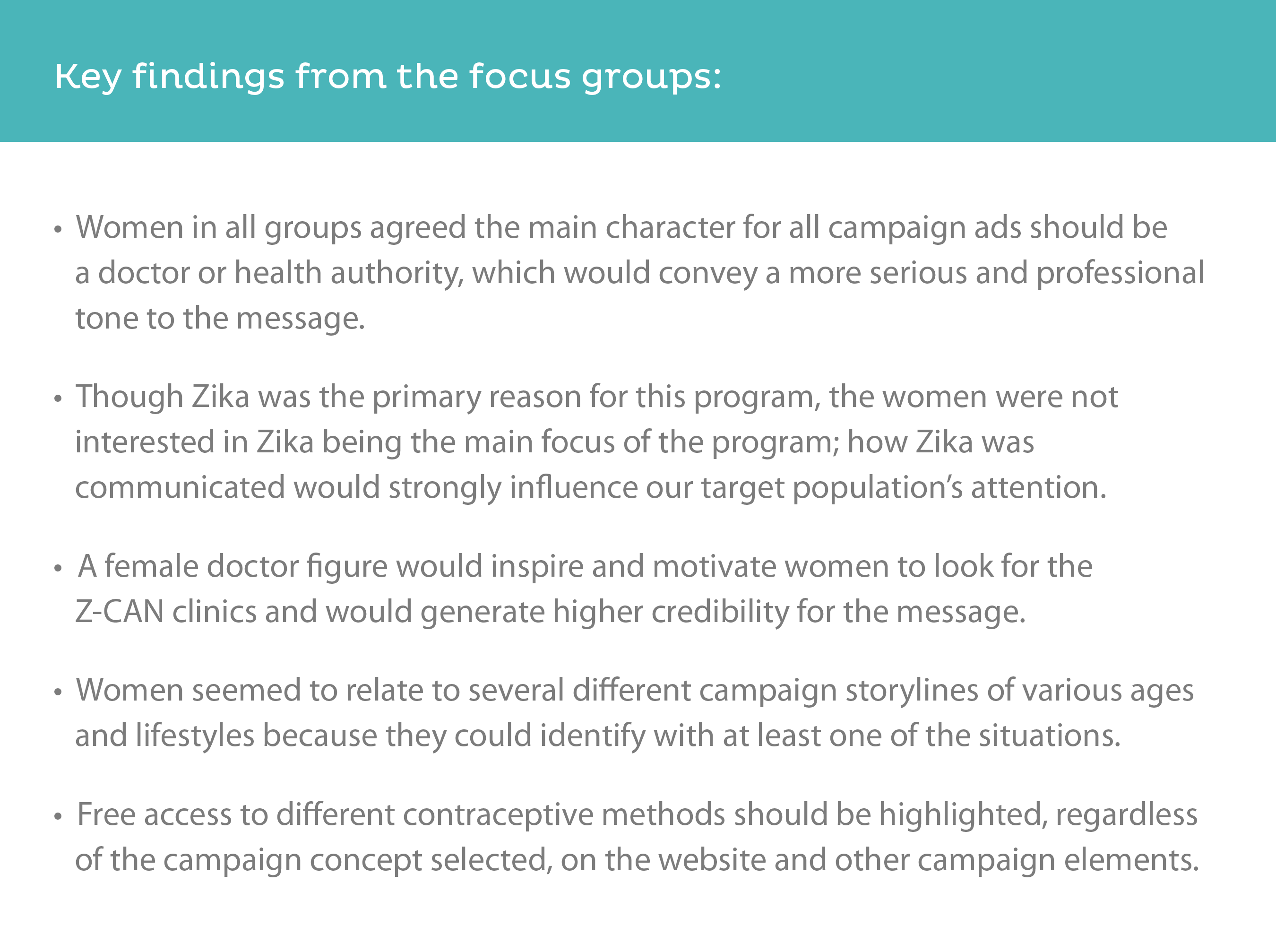
Key findings from the focus groups:
- Women in all groups agreed the main character for all campaign ads should be a doctor or health authority, which would convey a more serious and professional tone to the message.
- Though Zika was the primary reason for this program, the women were not interested in Zika being the main focus of the program; how Zika was communicated would strongly influence our target population's attention.
- A female doctor figure would inspire and motivate women to look for the Z-CAN clinks and would generate higher credibility for the message.
- Women seemed to relate to several different campaign storylines of various ages and lifestyles because they could identify with at least one of the situations.
- Free access to different contraceptive methods should be highlighted, regardless of the campaign concept seleted, on the website and other campaign elements.
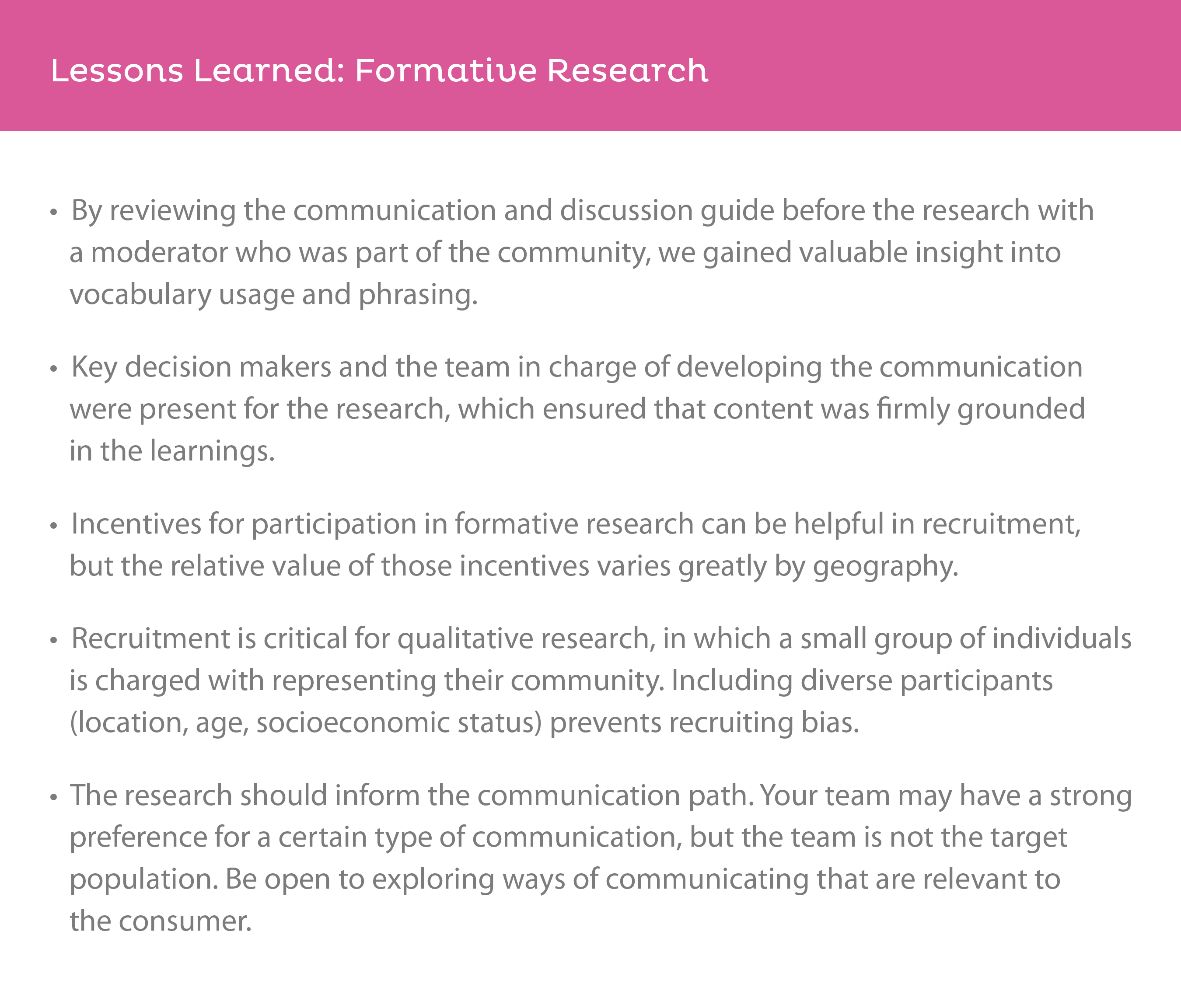
Lessons Learned: Formative Research
- By reviewing the communication and discussion guide before the research with a moderator who was part of the community, we gained valuable insight into vocabulary usage and phrasing.
- Key decision makers and the team in charge of developing the communication were present for the research, which ensured that content was firmly grounded in the learnings.
- Incentives for participation in formative research can be helpful in recruitment, but the relative value of those incentives varies greatly by geography.
- Recruitment is critical for qualitative research, in which a small group of individuals is charged with representing their community. Including diverse participants (location, age, socioeconomic status) prevents recruiting bias.
- The research should inform the communication path. Your team may have a strong preference for a certain type of communication, but the theam is not the target population. Be open to exploring ways of communicating that are relevant to the consumer.
RESOURCES AVAILABLE:
During formative research you might talk to a broad group that represents the target population, but once you are developing messages, define your target as narrowly as possible (age, life stage, lifestyle, affinities, perceptions/barriers, media habits, and other key characteristics). As you narrow your audience to enable more effective targeting, consider who is the most receptive, who represents the greatest challenge, and who influences the audience you want to reach.
Z-CAN Example: Target Audience
We needed to have a clear understanding of Puerto Rican women of reproductive age 18–49 who chose to delay or prevent pregnancy. Through the formative research, we identified four different lifestyle/life stage segments in the reproductive age group with potentially different reproductive concerns: young college-aged women, single professional women, recently married women, and women who already had children. We developed messaging for each segment, tailoring messages to highlight specific concerns, questions, method types, or scenarios that were more relevant to these specific segments.
Once you have a clear picture of your target audience, you can map their journey. Journey Mapping means understanding where and when the intended audience goes for information, when they have their greatest need (or the highest level of anxiety), and what stages they go through to make their decision. As you map the consumer journey, consider the behaviors that an individual or community undertake that demonstrate a positive change toward the desired behavior; use those to identify types of communication that will help influence that positive movement and ultimately help measure a positive change toward the desired behavior.
You can develop a campaign strategy once you have:
- Reached a clear understanding of what you aim to change and how you propose changing it
- Gained insights about the knowledge, attitudes, and behaviors of the target population related to the topic
- Determined the best ways to reach the target population and what channels they are currently using and trust
- Identified dynamics that could affect the success of the program (behavioral and structural barriers, potential backlash, competing interests)
Development of Communications Brief: Now you are ready to develop a Communications Brief that serves as the strategic guidepost against which you can evaluate all of your communication elements to ensure they remain consistent with the campaign strategy. The Communications Brief will articulate:
- The objective or the measurable behavioral results you expect to achieve
- The target audience defined as narrowly as possible, as if you are speaking to a specific person
- The challenge or problem the communication must solve and the corresponding opportunity (based on what you learned in the research)
- The strategy statement on how you plan to address the challenge and opportunity
- Behavior dynamics that include the current belief and corresponding behavior and the desired belief and behavior
RESOURCE AVAILABLE:
Team Assignment: Assembling the right cross-functional team to develop the campaign platform theme, the campaign plan, and all the necessary elements is the next critical step. The best teams include a mix of creative thinkers, detail-oriented implementation managers, and subject matter experts. You will use the Communications Brief (and any other pertinent project background) to kick off the Creative Process.
Creative Process: The goal of the creative process is to explore a range of platform concepts (an umbrella campaign theme that ties all the communication together) representing different pathways to change a behavior.
RESOURCE AVAILABLE:
The next step is to compile the top concepts (usually three) for the entire project team to review. Each umbrella concept should include:
- An overview of how this concept answers the strategic criteria established in the Communications Brief
- An insight on why the concept addresses the intended audience behavior
- A central theme/message
- A write-up (and maybe a key visual) that explains the concept
After the team selects one concept, based on a pre-established review process and potential audience testing, the platform will serve as the springboard for all communication.
Z-CAN Example: Ante La Duda, Pregunta (ALDP) (When in Doubt, Ask)
The Z-CAN team determined that communications should feature meaningful and personal messaging and relevant tactics that were true to the target population’s values, and that took into consideration their current behavior related to contraception and cultural and social influences in their lives. That finding led directly to formation of Z-CAN’s health communication campaign concept, ALDP, which validated the uncertainty many women feel about birth control and normalized asking questions about contraceptive methods, while providing answers to the most prevalent questions. By empowering the women, ALDP helped them shift from simply following what others were doing, to being well informed and able to choose what was right for them.
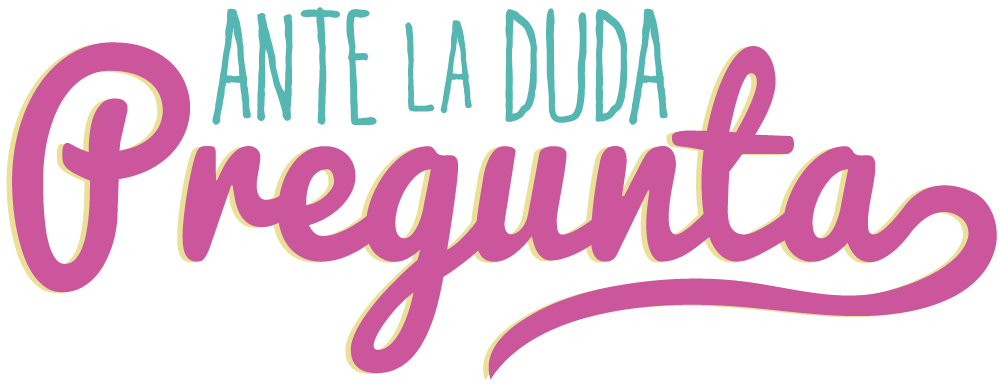

Developing the Right Message in the Right Context:
Now that you have a clear understanding of the target audience and you have the communications platform, you can develop specific content—the right messages for the right contexts (when the target is most receptive or when or where it is most critical to deliver the message). Effective consumer communication engages the audience in a conversation, provides valuable information, and prompts action. Program content must be interesting, credible, meaningful to the target and disseminated in relevant environments. Spokespersons and influencers must be authentic and believable.
Z-CAN Example: ALDP Branding
For Z-CAN we developed ALDP as the platform campaign under which we included specific messages for specific purposes. The brand established the overall story and provided a consistent look, feel, and tone for all communications. Specific messages addressed different audience situations, seasonal contexts, methods of contraception, and key questions to ask the doctor, in a mix of emotion-driven messages and fact-based educational messages. Four relatable personas of different ages and marital status were developed for the ALDP campaign. These personas shared their experiences and encouraged behaviors such as visiting a clinic to learn about contraception options available to her. We monitored the performance of each message on digital platforms (Facebook and Google/YouTube) and developed new messages based on the learning.
Determining the Right Media to Reach and Engage the Audience: Using Owned, Earned, and Paid Channels:
- Owned: These are communications channels owned or controlled by your organization, for example, your website, Facebook page, proprietary events, or any facilities and locations you control.
- Earned: Securing presence in other media that does not require paying for the space (such as a public service announcement [PSA] or press coverage) or establishing partnerships with other media is also efficient and can add credibility.
- Paid: This necessary component ensures your message is seen by the right audience(s). It can include boosting (promoting) social ads, digital display ads, paid search, TV, radio, print, or outdoor advertising.
Z-CAN Example: ALDP Website and Facebook (Owned)
For the ALDP campaign, we needed a website hub for information and resources, presence in social media, presence in the community (including doctors’ offices), and presence in print and digital media.
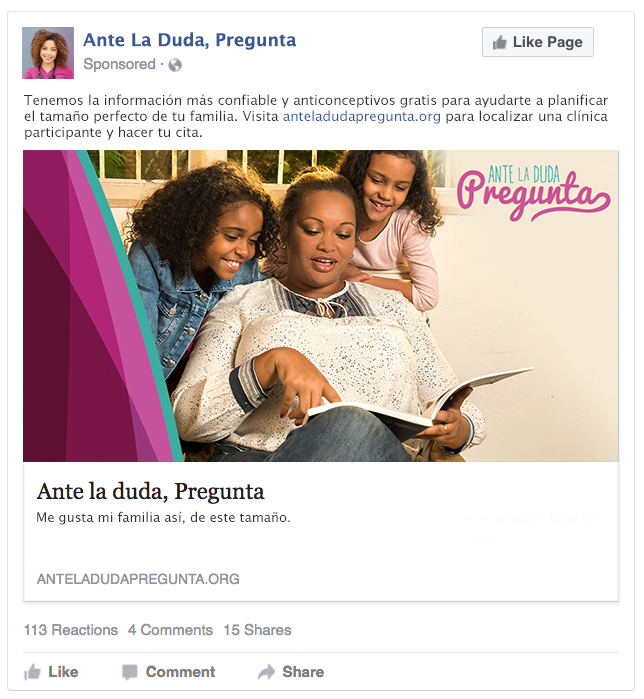
Owned: The ALDP website and ALDP Facebook page were our primary owned channels, requiring the greatest investment of time and money; we also created and distributed provider materials.
Our Spanish-language ALDP website hub (with an English toggle) for consumers included educational text and video content on contraceptives, a clinic search feature that allowed women to locate a Z-CAN clinic/provider, frequently asked questions (FAQs), and testimonials.
- Our Facebook page was designed to build a community that served as a "safe space" with two purposes:
- to enable or encourage sharing and discussion about important facts or key questions to ask about birth control
- to inform and educate the target population on the access to free contraceptives through the Z-CAN program.
It also was a hub for recruiting, engaging, and activating influencers (paid and unpaid). To ensure accuracy and consistency of responses via Facebook messages or comments, community managers developed Response Guidelines that included pre-approved responses and a reference FAQ.
RESOURCES AVAILABLE:
- 4.4a ALDP Carousel Ad Sample
- 4.4b ALDP Carousel Ad Approval Form
- 4.4c ALDP Sample Post Calendar - Content Placement Log
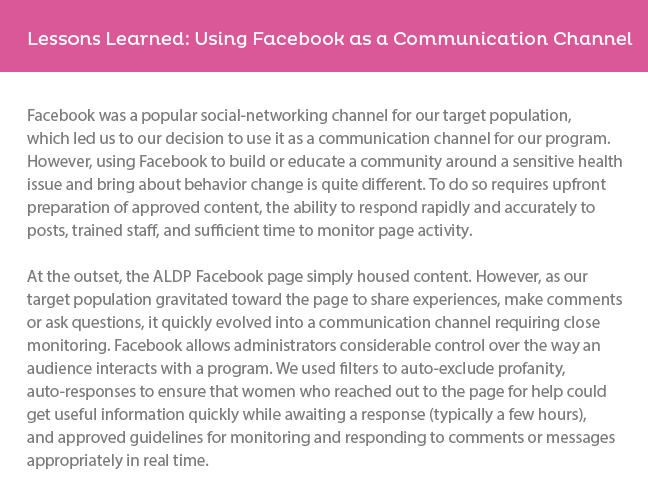
Lessons Learned: Formative Research
Facebook was a popular social-networking channel for our target population, which led us to our decision to use it as a communication channel for our program. However, using Facebook to build or educate a community around a sensitive health issue and bring about behavior change is quite different. To do so requires upgrount preparation of approved content, the ability to respond rapidly and accurately to posts, traned staff, and sufficient time to monitor page activity.
At the outset, the ALDP Facebook page simply housed content. However, as our target population gravitated toward the page to share experiences, make comments or ask questions, it quickly evolved into a communication channel requiring close monitoring. Facebook allows administrators considerable control over the way an audience interacts with a program. We used filters to auto-exclude profanity, auto-response to ensure that women who reached out to the page for help could get useful information quickly while awaiting a response (typically a few hours), and approved guidelines for monitoring and responding to comments or messages appropriately in real time.
Z-CAN Example: Campaign Communications for Providers
Communications for providers is an example of owned media. Z-CAN provider communications included:
- Programmatic Information: Providers received a welcome letter/kit, program updates, and Q&A talking points to ensure they were prepared to deliver Zika urgency message to patients—one that the campaign itself did not deliver. Clinic toolkits included ALDP posters, brochures, and handouts.
- Social Media Outreach: Initially the Z-CAN team hoped to include physicians' social channels as part of the plan. Unfortunately, few physicians actively used social media.
RESOURCES AVAILABLE:
Earned: Establishing partnerships with entities, including relevant news media outlets, that reach the intended audience(s) can be a highly efficient way to secure coverage and build support. Reaching out to social media influencers, member organizations, and other entities who cover relevant subjects can lead to partnerships that extend the reach of your campaign. Influencers who choose to cover your program or event to support a social cause or for some other reason and are not paid fall into the Earned category.
Influencer programs can provide a reduced cost and more effective alternative to traditional celebrity or media endorsements. The key to success is creating content that encourages influencers to share with their networks. Influencer programs are an element of paid social media when the influencers are paid for their posts on their social channels, but influencer programs can also be nonpaid (if influencers decide to support something they believe in).
Z-CAN Example: Influencer Program
To amplify ALDP campaign messages, we identified and recruited Puerto Rican influencers and bloggers as partners. Only a few of the influencers were in the health care arena, but many were invited to join as partners due to their audience’s similarity with that of the ALDP. The team worked both with influencers who were compensated for their social media posts and content they created, and unpaid influencers who created content based on a passion or interest. We provided each influencer, whether paid or unpaid, language on the campaign and example social media posts that they could disseminate through their social media channels (Twitter, Facebook, Instagram) and their blogs. The influencers also received campaign updates, highlights of events, and additional campaign materials, including videos and imagery they could use in their posts.
Community engagement: Community buy-in should be a crucial part of any major cause-related or behavior-change effort. A well-thought-out community engagement plan creates efficiency, helps maintain interest and engagement in the program, and reduces the need to rely on paid media. Community events are a way to extend the reach of a public health campaign by bringing the message to venues where the target lives, works, or plays. Alignment with local nonprofit organizations and community centers lends authenticity, credibility, and trustworthiness to the project. Community engagement materials do not have to be costly; handouts, giveaways, and postcards all can be effective communications means for events.
Z-CAN Example: Community Engagement
The ALDP effort included grassroots community-engagement events in various settings throughout Puerto Rico, with the goal of extending the campaign’s reach. Staff attended a range of community events promoting the ALDP campaign, including health fairs, festivals, marathons and walks, presentations to community groups, and on-campus events at universities. Women in the area had the opportunity to meet the local Puerto Rico Z-CAN staff, learn more about the Z-CAN program, and ask questions. Attendees received materials to educate them about the Z-CAN program and to increase program recognition. We created ALDP-specific promotional materials to recruit and educate potential participants: posters, grocery shopping bags, button pins, and phone wallets with credit card slots (see images below).
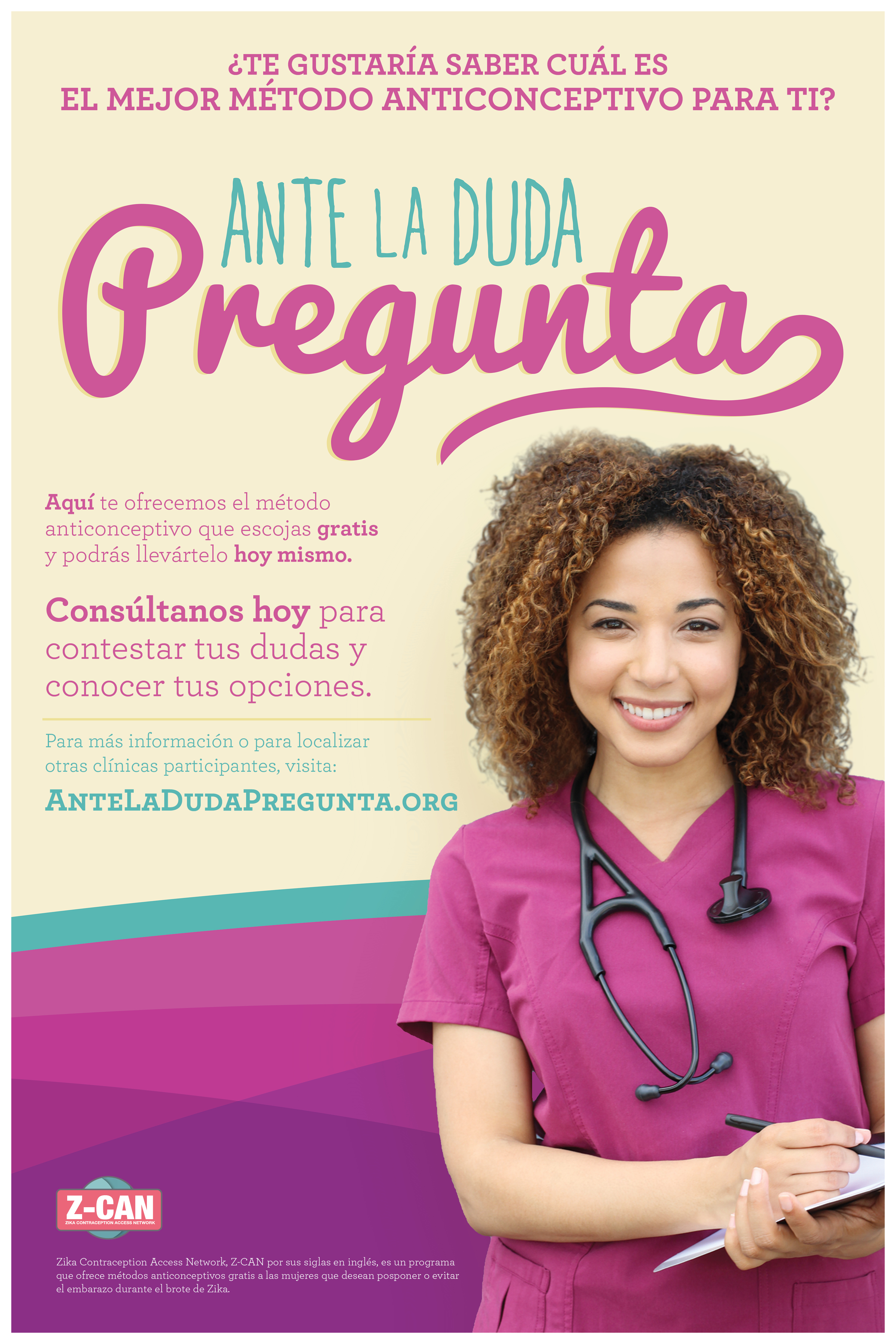
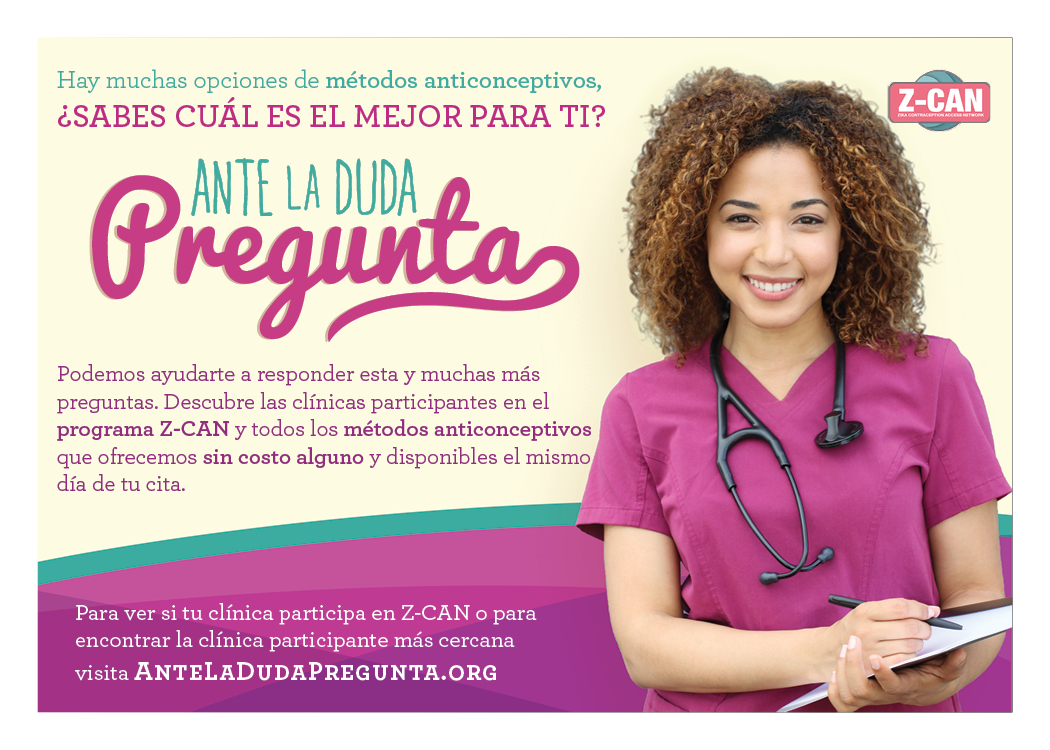
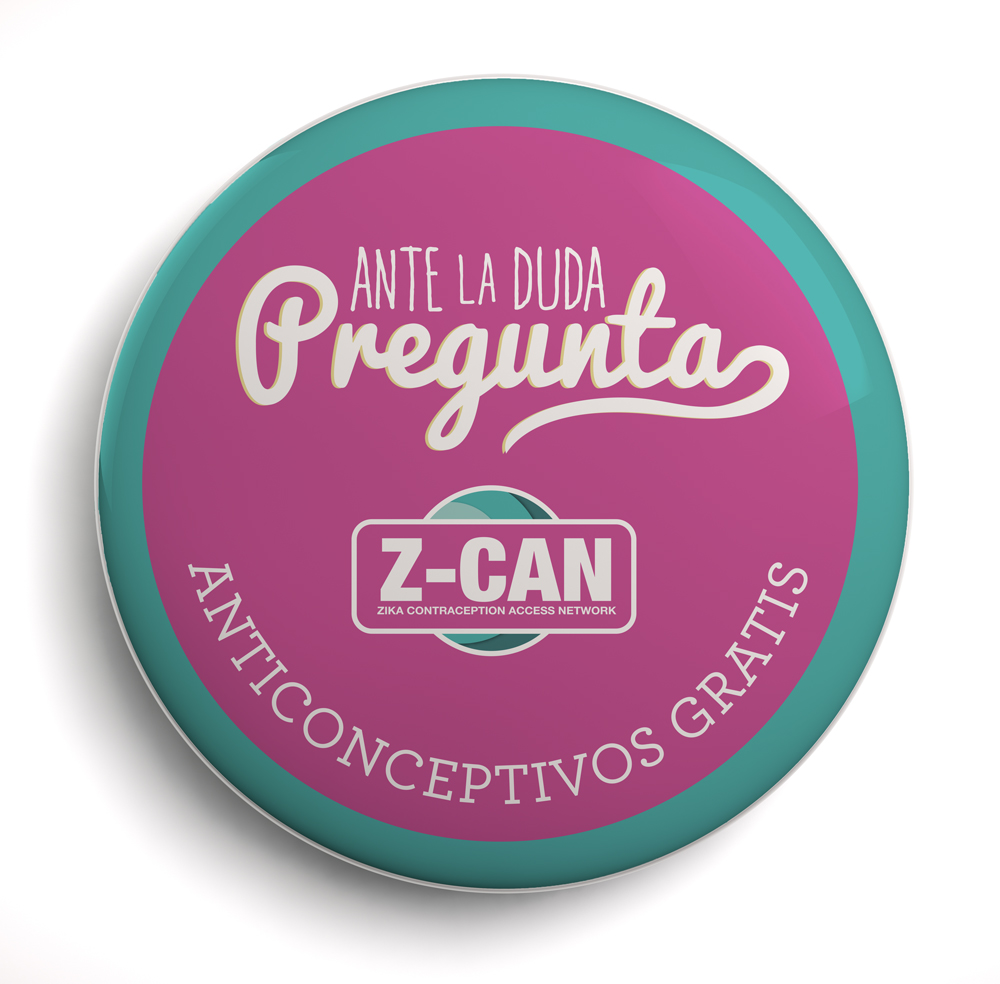
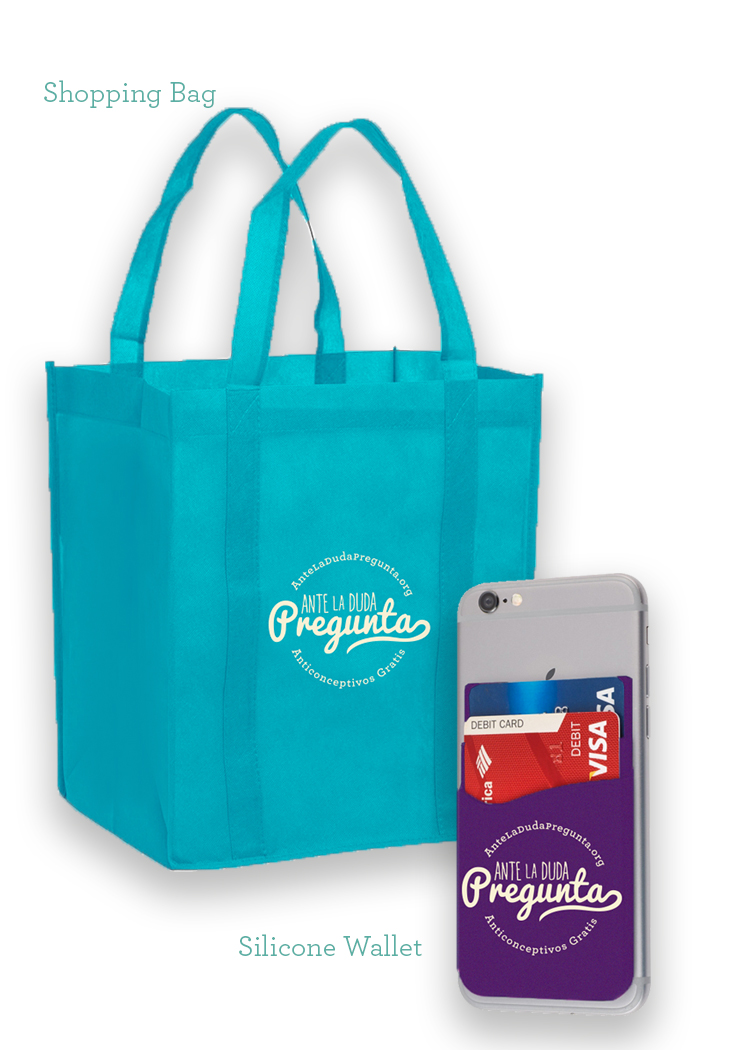
RESOURCES AVAILABLE:
- 4.4g Health-Related Community-Engagement Effort Promotoras One-Pager
- 4.4h ALDP Community-Engagement Request to Participate Letter Template
- 4.4i ALDP Presentation for Community Members
Paid: Developing a targeted media buy across digital and broadcast channels, while costly, is a guaranteed way to reach specific audiences.
Z-CAN Example: Paid Radio
For the ALDP campaign, we used radio spots, PSAs, live DJ mentions or live reads, and on-air interviews. Unlike many major markets in the United States, radio stations in Puerto Rico were not measured, so the team had to determine alternate metrics to monitor performance of this channel. We looked at airtime and number of spots run as a proxy for impression levels (the average number of people estimated to have been listening to the radio station during the time when the radio ad aired).
RESOURCES AVAILABLE:
4.4j Examples of the Use of Radio in a Health Education Program:
Z-CAN Example: Paid Social Media (Facebook)
Two primary ways that can ensure your communication reaches the desired audience on social media are: (1) boosting/promoting posts and (2) paid ads. Boosting or promoting posts is a great way to maximize the visibility and reach of content you have already published through Facebook or Instagram, and if you are able to monitor performance of past posts, this can be a good way to focus your media spend on messages that have already shown strong performance (engagement, reactions, shares, link clicks).
Paid ads enable a communications team to quickly and efficiently test multiple different messages or versions of an ad (different calls to action, images, or proof points) and use the version that performs best.
ALDP created a master calendar of both organic posts and paid social ads to ensure efficient spending of the overall social media budget, and to ensure that the body of content told a story across the entire length of the campaign. We needed to ensure we had different paid social ads or promoted posts targeting distinct parts of the overall target audience in Puerto Rico at different times. We also planned a video content calendar, running our videos first as ads, then posting the best-performing videos to our Facebook page. ALDP grew a Facebook community from 0 to over 25,000 followers.
Z-CAN Example: Paid Digital (Google)
Google also can be a strong partner for digital campaigns. Google offers business tools through AdWords and Analytics that enable users to create, place, and monitor performance of range of advertising types, and link those ads’ performance to specific actions on the campaign’s website.
RESOURCE AVAILABLE:
Measurement and evaluation contribute to long-term program success. Solid behavior-change programs incorporate frequent review of results and subsequent modification of messaging and tactics to increase program effectiveness and sustainability.
Key Components of a Measurement Plan
- Consumer Journey: Identify the key behavior change desired and the steps an individual or community would take that support progress toward that goal. Identify key opportunities where communication could positively influence progress toward the behavior-change goal.
- Logic Model: For the behavior you aim to change through use of a communications campaign, identify the short- and intermediate-term outcomes that will result in the behavior change and the communication activities and outputs needed to achieve the outcomes.
- Evaluation Plan: Develop evaluation questions, key metrics, and data sources for monitoring campaign progress and assessing effectiveness of the campaign. In addition, agree on frequency for collecting and reviewing campaign metrics and identifying opportunities to improve the campaign or make adjustments based on collected data.
- Centralized Data Collection: Identify a person responsible for collecting data for each metric in the evaluation plan.
RESOURCES AVAILABLE:
Z-CAN Example: Measurement and Evaluation
See ALDP M&E Logic Model for how measurement and evaluation were incorporated into a health-services program.
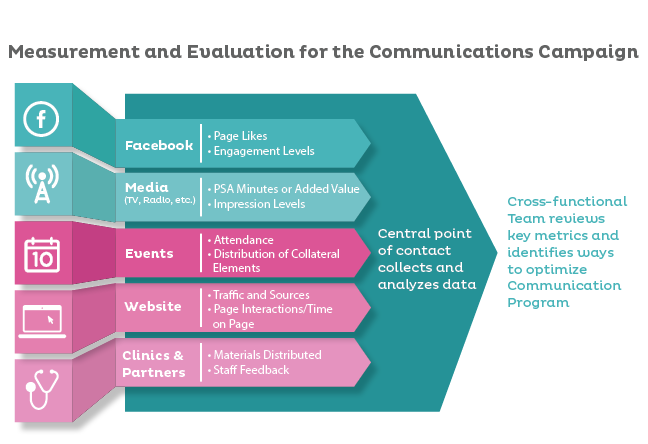
For the ALDP campaign, the team analyzed metrics to ascertain numbers and geographic distribution of clinic searches, positive vs. negative responses, and strength of message and medium. Results were used to tweak various campaign elements as well as to identify new content needs or address frequent concerns.



